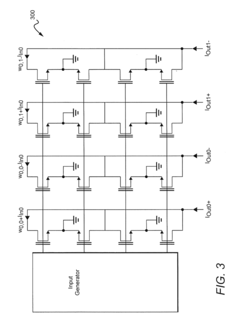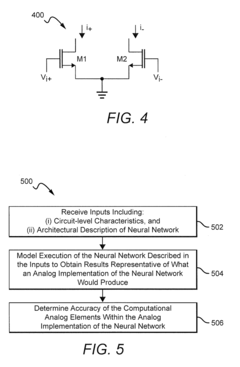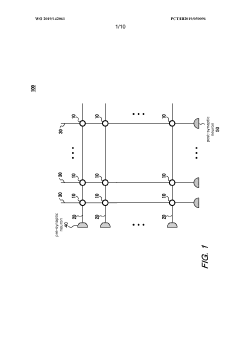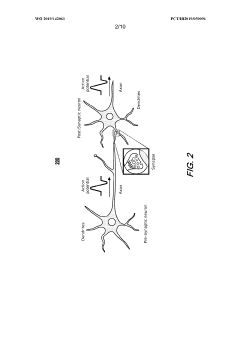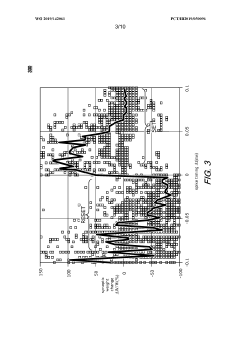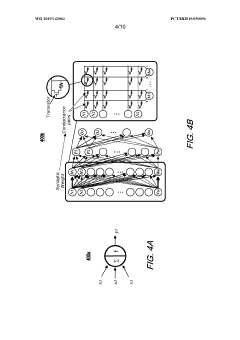The Impact of Neuromorphic Chips on Patented Neural Architectures
OCT 9, 20259 MIN READ
Generate Your Research Report Instantly with AI Agent
Patsnap Eureka helps you evaluate technical feasibility & market potential.
Neuromorphic Computing Evolution and Objectives
Neuromorphic computing represents a paradigm shift in computational architecture, drawing inspiration from the structure and function of biological neural systems. This field has evolved significantly since the pioneering work of Carver Mead in the late 1980s, who first coined the term "neuromorphic" to describe analog circuits that mimic neuro-biological architectures. The evolution trajectory has moved from simple analog implementations to sophisticated hybrid analog-digital systems capable of emulating complex neural behaviors.
The fundamental objective of neuromorphic computing is to overcome the limitations of traditional von Neumann architecture by creating systems that process information in a parallel, distributed manner similar to biological brains. This approach promises significant advantages in energy efficiency, with neuromorphic chips potentially consuming orders of magnitude less power than conventional processors for certain tasks, particularly those involving pattern recognition and sensory processing.
Recent technological advancements have accelerated development in this field, with major milestones including IBM's TrueNorth chip (2014), Intel's Loihi (2017), and BrainChip's Akida (2019). These innovations demonstrate the growing maturity of neuromorphic hardware implementations and their potential for commercial applications. The progression from research prototypes to commercially viable products marks a critical transition in the field's evolution.
The convergence of neuromorphic computing with patented neural architectures presents both opportunities and challenges. As neuromorphic chips become more sophisticated, they increasingly overlap with proprietary neural network designs protected by patents. This intersection raises important questions about how hardware implementations might influence or be constrained by existing intellectual property in neural network architectures.
Current research objectives focus on several key areas: improving the scalability of neuromorphic systems to approach the complexity of biological brains; enhancing the integration of learning capabilities directly into hardware; developing more efficient spike-based communication protocols; and creating standardized programming frameworks that abstract hardware complexities for application developers.
Looking forward, the field aims to bridge the gap between neuroscience and computing, incorporating more biologically realistic features while maintaining practical engineering constraints. The ultimate goal remains creating computing systems that can approach the brain's remarkable efficiency in processing sensory information, learning from experience, and adapting to new environments, while navigating an increasingly complex landscape of patented neural architectures.
The fundamental objective of neuromorphic computing is to overcome the limitations of traditional von Neumann architecture by creating systems that process information in a parallel, distributed manner similar to biological brains. This approach promises significant advantages in energy efficiency, with neuromorphic chips potentially consuming orders of magnitude less power than conventional processors for certain tasks, particularly those involving pattern recognition and sensory processing.
Recent technological advancements have accelerated development in this field, with major milestones including IBM's TrueNorth chip (2014), Intel's Loihi (2017), and BrainChip's Akida (2019). These innovations demonstrate the growing maturity of neuromorphic hardware implementations and their potential for commercial applications. The progression from research prototypes to commercially viable products marks a critical transition in the field's evolution.
The convergence of neuromorphic computing with patented neural architectures presents both opportunities and challenges. As neuromorphic chips become more sophisticated, they increasingly overlap with proprietary neural network designs protected by patents. This intersection raises important questions about how hardware implementations might influence or be constrained by existing intellectual property in neural network architectures.
Current research objectives focus on several key areas: improving the scalability of neuromorphic systems to approach the complexity of biological brains; enhancing the integration of learning capabilities directly into hardware; developing more efficient spike-based communication protocols; and creating standardized programming frameworks that abstract hardware complexities for application developers.
Looking forward, the field aims to bridge the gap between neuroscience and computing, incorporating more biologically realistic features while maintaining practical engineering constraints. The ultimate goal remains creating computing systems that can approach the brain's remarkable efficiency in processing sensory information, learning from experience, and adapting to new environments, while navigating an increasingly complex landscape of patented neural architectures.
Market Analysis for Brain-Inspired Computing Solutions
The brain-inspired computing market is experiencing unprecedented growth, driven by the increasing demand for efficient processing of complex neural networks and AI algorithms. Current market valuations place this sector at approximately $2.5 billion, with projections indicating a compound annual growth rate of 20-25% over the next five years. This growth trajectory is primarily fueled by applications in autonomous vehicles, advanced robotics, and edge computing devices where traditional computing architectures face significant limitations.
Neuromorphic chips represent a revolutionary approach to computing that mimics the brain's neural structure, offering substantial advantages in power efficiency and parallel processing capabilities. Market research indicates that these chips can achieve up to 1000 times better energy efficiency for certain neural network operations compared to conventional GPU solutions. This efficiency gain is particularly valuable in mobile and IoT applications where power constraints are critical.
The demand landscape shows distinct segmentation across industries. Healthcare applications, including medical imaging and diagnostic systems, currently constitute approximately 28% of the market share. Automotive and transportation sectors follow at 23%, with particular emphasis on real-time decision-making systems for autonomous navigation. Financial services represent another significant segment at 18%, primarily utilizing these technologies for fraud detection and algorithmic trading.
Geographically, North America leads the market with approximately 42% share, followed by Asia-Pacific at 31%, which is experiencing the fastest growth rate due to substantial investments in AI infrastructure by countries like China, Japan, and South Korea. Europe accounts for 22% of the market, with particular strength in research and development of specialized neuromorphic applications.
Customer needs analysis reveals three primary market drivers: power efficiency requirements for edge computing applications, the need for real-time processing of sensory data, and increasing demand for on-device AI capabilities that reduce reliance on cloud infrastructure. Organizations are increasingly seeking solutions that can process complex neural architectures locally while maintaining strict power budgets.
The competitive landscape is characterized by both established semiconductor companies and specialized startups. Intel's Loihi, IBM's TrueNorth, and BrainChip's Akida are among the leading commercial neuromorphic solutions, each targeting different segments of the market. Additionally, academic research centers and government-funded initiatives continue to contribute significantly to market innovation, particularly in developing novel neural architectures optimized for neuromorphic hardware.
Market barriers include high initial development costs, compatibility challenges with existing software ecosystems, and the need for specialized programming paradigms. Despite these challenges, the market shows strong indicators of continued expansion as neuromorphic technologies mature and integration pathways become more established.
Neuromorphic chips represent a revolutionary approach to computing that mimics the brain's neural structure, offering substantial advantages in power efficiency and parallel processing capabilities. Market research indicates that these chips can achieve up to 1000 times better energy efficiency for certain neural network operations compared to conventional GPU solutions. This efficiency gain is particularly valuable in mobile and IoT applications where power constraints are critical.
The demand landscape shows distinct segmentation across industries. Healthcare applications, including medical imaging and diagnostic systems, currently constitute approximately 28% of the market share. Automotive and transportation sectors follow at 23%, with particular emphasis on real-time decision-making systems for autonomous navigation. Financial services represent another significant segment at 18%, primarily utilizing these technologies for fraud detection and algorithmic trading.
Geographically, North America leads the market with approximately 42% share, followed by Asia-Pacific at 31%, which is experiencing the fastest growth rate due to substantial investments in AI infrastructure by countries like China, Japan, and South Korea. Europe accounts for 22% of the market, with particular strength in research and development of specialized neuromorphic applications.
Customer needs analysis reveals three primary market drivers: power efficiency requirements for edge computing applications, the need for real-time processing of sensory data, and increasing demand for on-device AI capabilities that reduce reliance on cloud infrastructure. Organizations are increasingly seeking solutions that can process complex neural architectures locally while maintaining strict power budgets.
The competitive landscape is characterized by both established semiconductor companies and specialized startups. Intel's Loihi, IBM's TrueNorth, and BrainChip's Akida are among the leading commercial neuromorphic solutions, each targeting different segments of the market. Additionally, academic research centers and government-funded initiatives continue to contribute significantly to market innovation, particularly in developing novel neural architectures optimized for neuromorphic hardware.
Market barriers include high initial development costs, compatibility challenges with existing software ecosystems, and the need for specialized programming paradigms. Despite these challenges, the market shows strong indicators of continued expansion as neuromorphic technologies mature and integration pathways become more established.
Current Neuromorphic Chip Technology Landscape
The neuromorphic chip landscape has evolved significantly over the past decade, with major technological advancements from both academic institutions and industry leaders. Currently, several prominent neuromorphic architectures dominate the market, each with distinct approaches to emulating brain-like computing. IBM's TrueNorth represents one of the pioneering commercial neuromorphic chips, featuring a million digital neurons and 256 million synapses organized in a modular, scalable architecture optimized for real-time pattern recognition tasks.
Intel's Loihi chip has emerged as another significant player, incorporating 130,000 neurons and 130 million synapses with on-chip learning capabilities. The second-generation Loihi 2 further advances this architecture with improved neuron models and enhanced learning rules, demonstrating Intel's commitment to neuromorphic research. These developments have established a foundation for applications in robotics, optimization problems, and sparse coding.
BrainChip's Akida neural processor represents a commercial implementation focused on edge computing applications, emphasizing ultra-low power consumption while maintaining high performance for AI inference tasks. This architecture specifically targets IoT devices and autonomous systems where power constraints are critical.
The SpiNNaker system, developed at the University of Manchester, takes a different approach by using ARM processors to simulate large-scale neural networks. This platform enables researchers to model various neural architectures at scale, though with different power and performance characteristics than dedicated neuromorphic hardware.
In the analog domain, several research institutions have developed mixed-signal neuromorphic chips that more closely mimic biological neural dynamics. Notable examples include Stanford's Neurogrid and the University of Zurich's DYNAP-SE chip, which implement analog circuits to model neuron behavior while using digital communication for spike transmission.
The current technological landscape also features specialized neuromorphic vision sensors, such as Dynamic Vision Sensors (DVS) and DAVIS cameras, which process visual information in an event-based manner similar to the human retina. These sensors have been integrated with neuromorphic processors to create efficient vision processing systems.
From a geographical perspective, neuromorphic research centers are distributed globally, with significant contributions from North America (IBM, Intel, BrainChip), Europe (SpiNNaker, DYNAP-SE), and emerging efforts in Asia, particularly from China's Brain-Inspired Computing Research Center and Japan's RIKEN institute.
The patent landscape surrounding neuromorphic chips has become increasingly complex, with cross-licensing agreements and strategic acquisitions shaping the competitive environment. Major technology companies have secured extensive patent portfolios covering neuromorphic architectures, learning algorithms, and hardware implementations, creating potential barriers for new entrants in this space.
Intel's Loihi chip has emerged as another significant player, incorporating 130,000 neurons and 130 million synapses with on-chip learning capabilities. The second-generation Loihi 2 further advances this architecture with improved neuron models and enhanced learning rules, demonstrating Intel's commitment to neuromorphic research. These developments have established a foundation for applications in robotics, optimization problems, and sparse coding.
BrainChip's Akida neural processor represents a commercial implementation focused on edge computing applications, emphasizing ultra-low power consumption while maintaining high performance for AI inference tasks. This architecture specifically targets IoT devices and autonomous systems where power constraints are critical.
The SpiNNaker system, developed at the University of Manchester, takes a different approach by using ARM processors to simulate large-scale neural networks. This platform enables researchers to model various neural architectures at scale, though with different power and performance characteristics than dedicated neuromorphic hardware.
In the analog domain, several research institutions have developed mixed-signal neuromorphic chips that more closely mimic biological neural dynamics. Notable examples include Stanford's Neurogrid and the University of Zurich's DYNAP-SE chip, which implement analog circuits to model neuron behavior while using digital communication for spike transmission.
The current technological landscape also features specialized neuromorphic vision sensors, such as Dynamic Vision Sensors (DVS) and DAVIS cameras, which process visual information in an event-based manner similar to the human retina. These sensors have been integrated with neuromorphic processors to create efficient vision processing systems.
From a geographical perspective, neuromorphic research centers are distributed globally, with significant contributions from North America (IBM, Intel, BrainChip), Europe (SpiNNaker, DYNAP-SE), and emerging efforts in Asia, particularly from China's Brain-Inspired Computing Research Center and Japan's RIKEN institute.
The patent landscape surrounding neuromorphic chips has become increasingly complex, with cross-licensing agreements and strategic acquisitions shaping the competitive environment. Major technology companies have secured extensive patent portfolios covering neuromorphic architectures, learning algorithms, and hardware implementations, creating potential barriers for new entrants in this space.
Existing Neuromorphic Implementation Approaches
01 Energy efficiency and power consumption optimization
Neuromorphic chips are designed to mimic the brain's neural networks, offering significant advantages in energy efficiency compared to traditional computing architectures. These chips optimize power consumption by using event-driven processing and spike-based communication, allowing for substantial energy savings in AI applications. The architecture enables efficient processing of neural network operations while maintaining low power requirements, making them suitable for edge computing and battery-powered devices.- Energy efficiency and power consumption optimization: Neuromorphic chips are designed to mimic the brain's neural networks, offering significant advantages in energy efficiency compared to traditional computing architectures. These chips optimize power consumption through specialized circuit designs and processing techniques that enable efficient handling of AI workloads. The energy-efficient nature of neuromorphic computing makes it particularly suitable for edge devices and applications where power constraints are critical, allowing for more sustainable AI implementations.
- Neural network implementation and processing capabilities: Neuromorphic chips provide specialized hardware for implementing neural networks with capabilities that include parallel processing, spike-based computation, and adaptive learning. These chips can efficiently process complex neural network architectures, enabling faster inference and training for various AI applications. The unique processing capabilities of neuromorphic chips allow for more effective handling of pattern recognition, sensory processing, and other cognitive tasks that traditional computing architectures struggle with.
- Applications in computer vision and image processing: Neuromorphic chips offer significant advantages in computer vision and image processing applications. Their architecture enables efficient processing of visual data, pattern recognition, and object detection with lower latency and power consumption. These chips can be integrated into various vision systems including surveillance cameras, autonomous vehicles, and augmented reality devices, enhancing their ability to process visual information in real-time while maintaining energy efficiency.
- Integration with edge computing and IoT devices: Neuromorphic chips are increasingly being integrated into edge computing platforms and IoT devices, enabling on-device AI processing without relying on cloud connectivity. This integration allows for real-time data processing, reduced latency, and enhanced privacy by keeping sensitive data local. The low power requirements and efficient processing capabilities of neuromorphic chips make them ideal for resource-constrained IoT environments, enabling smarter and more autonomous edge devices.
- Advancements in memristive and resistive memory technologies: Recent advancements in memristive and resistive memory technologies have significantly enhanced neuromorphic chip capabilities. These technologies enable more efficient synaptic weight storage and updates, closely mimicking biological neural processes. The integration of these advanced memory technologies with neuromorphic architectures allows for improved learning capabilities, reduced power consumption, and more compact chip designs, pushing the boundaries of what's possible in brain-inspired computing.
02 Neural network implementation and processing capabilities
Neuromorphic chips provide specialized hardware for implementing neural networks with improved processing capabilities. These chips feature parallel processing architectures that efficiently handle the computational requirements of artificial neural networks. They support various neural network models and learning algorithms, enabling more effective implementation of machine learning applications. The specialized circuitry allows for faster and more efficient execution of neural network operations compared to conventional computing systems.Expand Specific Solutions03 Applications in computer vision and image processing
Neuromorphic chips offer significant advantages in computer vision and image processing applications. Their architecture enables efficient processing of visual data, pattern recognition, and object detection. These chips can process image data in real-time with lower latency and power consumption compared to traditional processors. The event-based processing capability makes them particularly suitable for applications requiring continuous visual monitoring and analysis, such as surveillance systems, autonomous vehicles, and augmented reality.Expand Specific Solutions04 Integration with emerging memory technologies
Neuromorphic chips leverage emerging memory technologies to enhance their performance and capabilities. These include resistive random-access memory (ReRAM), phase-change memory (PCM), and other non-volatile memory technologies that can efficiently store synaptic weights. The integration of these memory technologies enables more efficient implementation of neural networks, reduces the energy required for data movement, and allows for on-chip learning capabilities. This approach addresses the memory bottleneck issues present in conventional computing architectures.Expand Specific Solutions05 Edge computing and IoT applications
Neuromorphic chips are particularly well-suited for edge computing and Internet of Things (IoT) applications due to their energy efficiency and processing capabilities. These chips enable AI processing directly on edge devices, reducing the need for cloud connectivity and data transmission. They support real-time processing of sensor data with minimal power consumption, making them ideal for smart devices, wearables, and autonomous systems. The ability to perform complex neural network computations at the edge enhances privacy, reduces latency, and enables new applications in resource-constrained environments.Expand Specific Solutions
Leading Companies in Neuromorphic Computing
The neuromorphic chip market is in its early growth phase, characterized by significant R&D investments but limited commercial deployment. Major players like IBM, Intel, and Samsung are driving innovation alongside emerging specialists such as Syntiant, Lingxi Technology, and Cambricon. The market is projected to reach $8-10 billion by 2028, growing at 20-25% CAGR, fueled by AI applications requiring energy-efficient computing. Technology maturity varies significantly: established players like IBM (TrueNorth) and Intel (Loihi) have advanced research platforms, while academic institutions (Tsinghua, Fudan) contribute foundational research. Chinese companies are rapidly advancing with government support, creating a competitive landscape where intellectual property and patent portfolios increasingly determine market positioning.
International Business Machines Corp.
Technical Solution: IBM's TrueNorth neuromorphic chip represents one of the most significant advancements in brain-inspired computing. The chip contains 1 million programmable neurons and 256 million synapses, consuming only 70mW of power while delivering 46 billion synaptic operations per second per watt. IBM's architecture implements a non-von Neumann computing paradigm where memory and processing are co-located, eliminating the traditional bottleneck between these components. The TrueNorth architecture uses a modular design with neurosynaptic cores that can be tiled to create larger systems, enabling scalability while maintaining energy efficiency. IBM has further developed SyNAPSE (Systems of Neuromorphic Adaptive Plastic Scalable Electronics) technology that incorporates spike-timing-dependent plasticity (STDP) for on-chip learning capabilities, allowing the system to adapt to new data patterns without explicit reprogramming.
Strengths: Exceptional energy efficiency (20,000 times more efficient than conventional chips), scalable architecture, and proven performance in pattern recognition tasks. Weaknesses: Limited to spiking neural network paradigms, requires specialized programming approaches different from mainstream deep learning frameworks, and faces challenges in training complex models compared to GPU-accelerated systems.
Intel Corp.
Technical Solution: Intel's Loihi neuromorphic research chip represents a significant advancement in brain-inspired computing architectures. The chip features 128 neuromorphic cores, each implementing 1,024 spiking neurons for a total of 131,072 neurons and 130 million synapses. Loihi incorporates a programmable microcode learning engine for on-chip training of neural network parameters, supporting various learning paradigms including unsupervised, supervised, and reinforcement learning. The architecture implements a fully asynchronous neuromorphic design where neurons communicate via discrete spikes, closely mimicking biological neural systems. Intel's second-generation Loihi 2 chip, released in 2021, features up to 1 million neurons and introduces programmable synaptic learning rules, allowing researchers to implement various plasticity mechanisms. The chip achieves up to 10x better performance per watt on deep learning workloads compared to conventional architectures while enabling novel computational capabilities for edge AI applications.
Strengths: Highly energy-efficient (up to 1,000 times more efficient than general-purpose computing for certain workloads), supports on-chip learning with flexible learning rules, and demonstrates excellent performance in temporal pattern recognition. Weaknesses: Still primarily a research platform rather than a commercial product, requires specialized programming expertise, and has limited software ecosystem compared to mainstream AI accelerators.
Key Patents in Brain-Inspired Computing
Systems And Methods For Determining Circuit-Level Effects On Classifier Accuracy
PatentActiveUS20190065962A1
Innovation
- The development of neuromorphic chips that simulate 'silicon' neurons, processing information in parallel with bursts of electric current at non-uniform intervals, and the use of systems and methods to model the effects of circuit-level characteristics on neural networks, such as thermal noise and weight inaccuracies, to optimize their performance.
Neuromorphic chip for updating precise synaptic weight values
PatentWO2019142061A1
Innovation
- A neuromorphic chip with a crossbar array configuration that uses resistive devices and switches to express synaptic weights with a variable number of resistive elements, allowing for precise synaptic weight updates by dynamically connecting axon lines and assigning weights to synaptic cells, thereby mitigating device variability and maintaining training power and speed.
IP Strategy for Neural Hardware Development
Developing a robust intellectual property strategy is essential for companies investing in neuromorphic computing hardware. The rapidly evolving landscape of neural architectures implemented in silicon demands a multi-faceted approach to IP protection and utilization. Organizations must first conduct comprehensive patent landscape analyses to identify existing protected technologies, white spaces for innovation, and potential infringement risks in the neuromorphic chip domain.
Strategic patent filing should focus on core innovations that differentiate neuromorphic hardware implementations, particularly those addressing power efficiency, novel synapse designs, and spike-based processing mechanisms. Companies should prioritize protection for architectural innovations that bridge the gap between biological neural systems and silicon implementations, as these represent high-value IP assets with long-term competitive advantages.
Defensive patenting strategies are equally important, creating protective barriers around primary technologies while establishing freedom to operate. This includes developing patent portfolios that cover not only the hardware architecture but also the specialized programming models, compiler technologies, and hardware-software interfaces unique to neuromorphic systems.
Cross-licensing opportunities present significant strategic value in this emerging field. As no single entity holds all necessary patents for comprehensive neuromorphic solutions, establishing strategic partnerships through IP exchanges can accelerate development cycles while reducing legal risks. Companies should identify potential partners whose IP portfolios complement their own technological gaps.
Open innovation approaches should be selectively incorporated into the IP strategy. Participating in industry standards development for neuromorphic interfaces and protocols can position a company's patented technologies as essential components of the ecosystem, while carefully managed open-source initiatives can drive adoption of proprietary hardware platforms.
Monitoring competitive patent activities is crucial for maintaining strategic advantage. Regular analysis of filing trends from both established semiconductor companies and neuromorphic startups provides early indicators of technological direction and potential market disruptions. This intelligence should directly inform R&D priorities and patent filing strategies.
Finally, companies must develop clear policies for handling IP developed through academic collaborations, as universities remain significant contributors to neuromorphic computing innovations. Establishing transparent frameworks for joint ownership, licensing rights, and publication permissions ensures productive partnerships while protecting commercial interests in this rapidly advancing field.
Strategic patent filing should focus on core innovations that differentiate neuromorphic hardware implementations, particularly those addressing power efficiency, novel synapse designs, and spike-based processing mechanisms. Companies should prioritize protection for architectural innovations that bridge the gap between biological neural systems and silicon implementations, as these represent high-value IP assets with long-term competitive advantages.
Defensive patenting strategies are equally important, creating protective barriers around primary technologies while establishing freedom to operate. This includes developing patent portfolios that cover not only the hardware architecture but also the specialized programming models, compiler technologies, and hardware-software interfaces unique to neuromorphic systems.
Cross-licensing opportunities present significant strategic value in this emerging field. As no single entity holds all necessary patents for comprehensive neuromorphic solutions, establishing strategic partnerships through IP exchanges can accelerate development cycles while reducing legal risks. Companies should identify potential partners whose IP portfolios complement their own technological gaps.
Open innovation approaches should be selectively incorporated into the IP strategy. Participating in industry standards development for neuromorphic interfaces and protocols can position a company's patented technologies as essential components of the ecosystem, while carefully managed open-source initiatives can drive adoption of proprietary hardware platforms.
Monitoring competitive patent activities is crucial for maintaining strategic advantage. Regular analysis of filing trends from both established semiconductor companies and neuromorphic startups provides early indicators of technological direction and potential market disruptions. This intelligence should directly inform R&D priorities and patent filing strategies.
Finally, companies must develop clear policies for handling IP developed through academic collaborations, as universities remain significant contributors to neuromorphic computing innovations. Establishing transparent frameworks for joint ownership, licensing rights, and publication permissions ensures productive partnerships while protecting commercial interests in this rapidly advancing field.
Energy Efficiency Benchmarks in Neuromorphic Systems
Energy efficiency represents a critical benchmark for evaluating neuromorphic computing systems, particularly as these brain-inspired architectures aim to deliver cognitive capabilities with significantly lower power consumption than traditional computing paradigms. Current neuromorphic chips demonstrate remarkable energy efficiency advantages, with leading implementations achieving power consumption in the milliwatt range while performing complex neural processing tasks that would require orders of magnitude more energy on conventional hardware.
The energy efficiency metrics for neuromorphic systems typically focus on synaptic operations per second per watt (SOPS/W), which provides a standardized measure for comparing different architectures. Intel's Loihi neuromorphic research chip, for instance, demonstrates approximately 4.8 trillion SOPS/W, representing a substantial improvement over traditional GPU implementations of neural networks. IBM's TrueNorth similarly achieves exceptional efficiency at 400 billion SOPS/W.
Patented neural architectures have significantly influenced these efficiency benchmarks through innovations in spike-based computing and event-driven processing. SpiNNaker's architecture, protected by multiple patents, utilizes a distributed memory approach that minimizes data movement, a primary energy cost in computing systems. Qualcomm's Zeroth platform incorporates patented techniques for sparse neural activation that substantially reduce computational overhead during inference tasks.
Comparative analysis reveals that neuromorphic implementations consistently outperform traditional computing architectures by 100-1000x in energy efficiency for specific workloads, particularly in pattern recognition and sensory processing tasks. This efficiency advantage stems from fundamental architectural differences, including local memory-processing integration, event-driven computation, and analog signal processing techniques covered by key patents in the field.
Temperature management represents another critical benchmark area, with neuromorphic systems generally operating at lower thermal outputs due to their distributed processing nature. This characteristic enables deployment in edge computing scenarios where active cooling would be impractical. Patents covering thermal management techniques specific to neuromorphic architectures have emerged as valuable intellectual property.
The efficiency frontier continues to advance through innovations in materials science, with patented memristor technologies demonstrating potential for another order-of-magnitude improvement in energy efficiency. These non-volatile memory elements can simultaneously store and process information, eliminating the energy-intensive data movement between separate memory and processing units that characterizes von Neumann architectures.
The energy efficiency metrics for neuromorphic systems typically focus on synaptic operations per second per watt (SOPS/W), which provides a standardized measure for comparing different architectures. Intel's Loihi neuromorphic research chip, for instance, demonstrates approximately 4.8 trillion SOPS/W, representing a substantial improvement over traditional GPU implementations of neural networks. IBM's TrueNorth similarly achieves exceptional efficiency at 400 billion SOPS/W.
Patented neural architectures have significantly influenced these efficiency benchmarks through innovations in spike-based computing and event-driven processing. SpiNNaker's architecture, protected by multiple patents, utilizes a distributed memory approach that minimizes data movement, a primary energy cost in computing systems. Qualcomm's Zeroth platform incorporates patented techniques for sparse neural activation that substantially reduce computational overhead during inference tasks.
Comparative analysis reveals that neuromorphic implementations consistently outperform traditional computing architectures by 100-1000x in energy efficiency for specific workloads, particularly in pattern recognition and sensory processing tasks. This efficiency advantage stems from fundamental architectural differences, including local memory-processing integration, event-driven computation, and analog signal processing techniques covered by key patents in the field.
Temperature management represents another critical benchmark area, with neuromorphic systems generally operating at lower thermal outputs due to their distributed processing nature. This characteristic enables deployment in edge computing scenarios where active cooling would be impractical. Patents covering thermal management techniques specific to neuromorphic architectures have emerged as valuable intellectual property.
The efficiency frontier continues to advance through innovations in materials science, with patented memristor technologies demonstrating potential for another order-of-magnitude improvement in energy efficiency. These non-volatile memory elements can simultaneously store and process information, eliminating the energy-intensive data movement between separate memory and processing units that characterizes von Neumann architectures.
Unlock deeper insights with Patsnap Eureka Quick Research — get a full tech report to explore trends and direct your research. Try now!
Generate Your Research Report Instantly with AI Agent
Supercharge your innovation with Patsnap Eureka AI Agent Platform!


